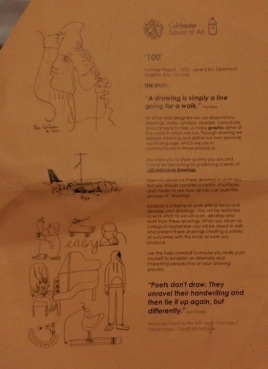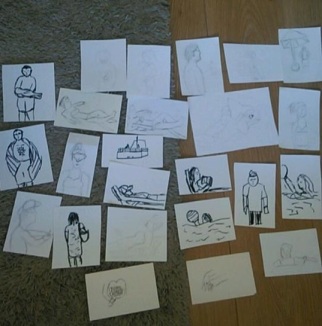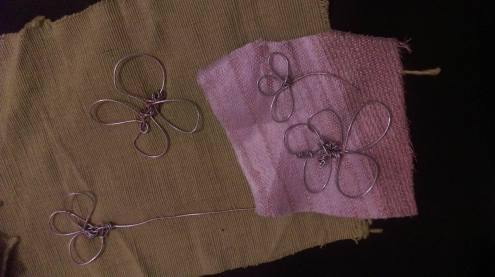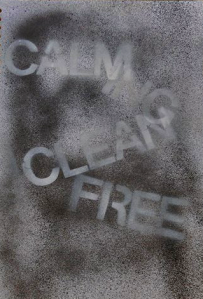BIBLIOGRAPHY
Abigail Reynolds.Abigail Reynolds. Available at: http://www.abigailreynolds.com/bibliography/ Accessed: May 9th, 2016
Alec Soth. Alec Soth. Available at: http://alecsoth.com/photography/?page_id=3 Accessed: May 17th, 2016
Anne brooke. H-anne- MADE by Ane Brooke Textile Artist. Available at: http://www.annebrooke.co.uk/#!gallery/gcidz Accessed: May 9th, 2016
Andrew Wyeth. Andrew Wyeth. Available at: http://andrewwyeth.com/gallery/ Accessed: May 17th, 2016
Art Net. Diane Arbus. Available at: http://www.artnet.com/artists/diane-arbus/ Accessed: April 10th, 2016.
Art 21. Leonardo Drew. Available at: http://www.art21.org/artists/leonardo-drew/slideshows Accessed: April 10th, 2016.
Asha Foster. (2016) Wrabness. Available at: https://www.youtube.com/watch?v=wgTwhlV2Dz0&feature=youtu.be (Accessed: 21st April 2016)
Bilyana Palankasova. 7. Available at: http://www.7sobm.co.uk/melissa-zexter/ Accessed: April 10th 2016.
Decider. DAVID LYNCH’S ‘MY BEAUTIFUL BROKEN BRAIN’ IS AS DIFFICULT AS IT IS BEAUTIFUL. Available at: http://decider.com/2016/03/25/why-you-should-watch-my-beautiful-broken-brain/ Accessed: June 4th 2016
Explorable. Nature vs Nurture. Available at: https://explorable.com/nature-vs-nurture-debate Accessed: May 19th 2016
Fran Sorin. Gardening Gone Wild. Available at: http://gardeninggonewild.com/?p=15578 Accessed: April 10th, 2016.
Grayson Perry’s Dream House. (2015). Channel 4. 24th April.
Munari, B. (1971) Design As Art. Penguin, London.
Blank Project. Francesca Prieto. Available at: http://www.blankproject.co.uk/series Accessed: May 9th, 2016
Eva-eun-sil-han. Eva-eun-sil-han. Available at: http://evahan.weebly.com/apophenia–2013.html Accessed: April 10th, 2016
ESCAPEINTOLIFE. Eva-eun-sil-han. Available at: http://www.escapeintolife.com/artist-watch/eva-eun-sil-han/ Accessed: April 10th, 2016
Fraenkel Gallery. EJ Bellocq. Avaliable at: https://fraenkelgallery.com/artists/ej-bellocq Accessed: May 17th, 2016
Fiona Watson. Fiona Watson. Available at: http://www.fionawatson.co.uk/about-fiona.html Accessed: April 10th, 2016
Guggenheim. Collection Online. Available at: https://www.guggenheim.org/artwork/artist/annette-messager Accessed: May 17th, 2016
Georgia O’Keefe. Georgia O’Keefe. Available at: http://www.georgiaokeeffe.net/ Accessed: May 17th, 2016.
Indiefixx. Jennifer Khoshbin. Available at: http://indiefixx.com/2009/07/01/wednesday-indie-artist-fixx-with-jennifer-khoshbin/ Accessed: May 24th 2016
JACK SHAINMAN GALLERY. El Anatsui. Available at: http://www.jackshainman.com/artists/el-anatsui/ Accessed: May 17th, 2016
JACK SHAINMAN GALLERY. Nick Cave. Available at: http://www.jackshainman.com/artists/nick-cave/ Accessed: April 10th, 2016.
James Castle. James Castle. Available at: http://jamescastle.com/genres/ Accessed: April 10th, 2016.
John Szarkowski. Atget Photography . com. Available at: http://www.atgetphotography.com/The-Photographers/BRASSAI.html Accessed at: 17th May, 2016
Lenore Tawney. Lenore Tawney. Available at: http://lenoretawney.org/lenore-tawney/work/ Accessed: April 10th, 2016.
Lisa Kokin. Lisa Kokin Artist. Available at: http://www.lisakokin.com/cv-bibliography.html Accessed: April 10th 2016.
Margret Berg. Margret Berg Art. Avaliable at: http://www.margaretbergart.com/ Accessed: April 8 2016.
Melissa Zexter. Melissa Zexter. Available at: http://www.melissazexter.com/about Accessed: April 10th, 2016.
Miyazaki, H (2015) My Neighbor Totoro Book, A film by Hayao Miyazaki. San Francisco, California.
MoMa. Christian Boltanski. Available at: http://www.moma.org/collection/artists/649 Accessed: May 17th, 2016
MoMA. Louise Bourgeois. Available at: http://www.moma.org/explore/collection/lb/ Accessed: April 10th, 2016.
MoMA. Weegee. Available at: http://www.moma.org/collection/artists/1842 Accessed: April 10th, 2016.
MoMA. William Kentridge. Available at: http://www.moma.org/interactives/exhibitions/2010/williamkentridge/flash/ Accessed: April 10th, 2016
Mousse Magazine. Maria Lai “To Sew Up the World” at MAN, Nuoro. Available at: http://moussemagazine.it/maria-lai-man-2014/ Accessed: April 10th, 2016.
‘My beautiful broken brain’. (2014). Netflix. 21st November.
Neverifigor. (2011)Twin Peaks- Red Room. Available at: https://youtu.be/u3IrMM0jc9M (Accessed: June 19th 2016).
Quora. Is introversion or extroversion nature or nurture? Available at: https://www.quora.com/Is-introversion-or-extroversion-nature-or-nurture Accessed: May 19th 2016
Sheila Hicks. Sheila Hicks. Available at: http://www.sheilahicks.com/ Accessed: April 10th, 2016.
Sophie Robbinson. Sophie Robbinson documentary filmmaker. Available at: http://sophie-robinson.com/about/%C2%A0 Accessed: June 4th 2016
Studio Line Juhl Hansen. Juhl Hansen. Available at: http://www.linejuhlhansen.dk/om-line Accessed: April 10th, 2016.
THE ART STORY. Eva Hesse. Available at: http://www.theartstory.org/artist-hesse-eva.htm Accessed: MAY 17th, 2016
The Guardian. My Beautiful Broken Brain: a painfully literal addition to the inspirational recovery canon. Available at: https://www.theguardian.com/film/2016/mar/19/my-beautiful-broken-brain. Accessed: June 4th 2016
The Guardian. Robert Frank. Available at: http://www.theguardian.com/artanddesign/2014/nov/07/robert-frank-americans-photography-influence-shadows Accessed: April 10th, 2016.
The independent. My Beautiful Broken Brain: The amazing collaboration of David Lynch and a woman who ‘video-selfied’ her stroke. Available at: http://www.independent.co.uk/arts-entertainment/films/features/my-beautiful-broken-brain-the-amazing-collaboration-of-david-lynch-and-a-woman-who-video-selfied-her-a6937571.html Accessed: June 19th 2016.
The J. Paul Getty Museum. Lisette Model. Available at: http://www.getty.edu/art/collection/artists/1521/lisette-model-american-born-austria-1901-1983/ Accessed: April 10th, 2016.
The Met. Walker Evans. Available at: http://www.metmuseum.org/toah/hd/evan/hd_evan.htm Accessed: April 10th, 2016.
The Tate. Man Ray. Available at: http://www.tate.org.uk/art/artists/man-ray-1563 Accessed: April 10th, 2016.
Tumblr. Ignacio Canales Aracil. Available at: http://el-nogal.tumblr.com/ Accessed: April 10th, 2016.
Uppercase. Abigail Reynolds, folded photographs. Available at: http://uppercase.squarespace.com/uppercase-journal/2009/11/17/abigail-reynolds-folded-photographs.html Accessed: May 9th 2016.
Valerie Solanis. SCUM manifesto. Available at: http://www.columbia.edu/itc/architecture/ockman/pdfs/feminism/solanis.pdf Accessed: May 2nd 2016.
Victoria Miro. Victoria Miro. Available at: http://www.victoria-miro.com/artists/31-yayoi-kusama/ Accessed: April 10th, 2016.
Vogue. Grayson Perry. Available at: http://www.vogue.co.uk/spy/biographies/grayson-perry-biography Accessed: April 24th 2016
Warhol. A (2016) ARTIST ROOMS: Andy Warhol. Colchester: FirstSite. 19th March − 12th June 2016.
WhenYoureGone (2014) Heather Hansen- Emptied Gestures. Available at: https://www.youtube.com/watch?v=_Spo2lE1pNY (Accessed: March 25th 2016)
White Cube. White Cube. Available at: http://whitecube.com/artists/doris_salcedo/ Accessed: May 17th, 2016
William Eggleston. William Eggleston. Available at: http://www.egglestontrust.com/ Accessed: April 10th, 2016.

































